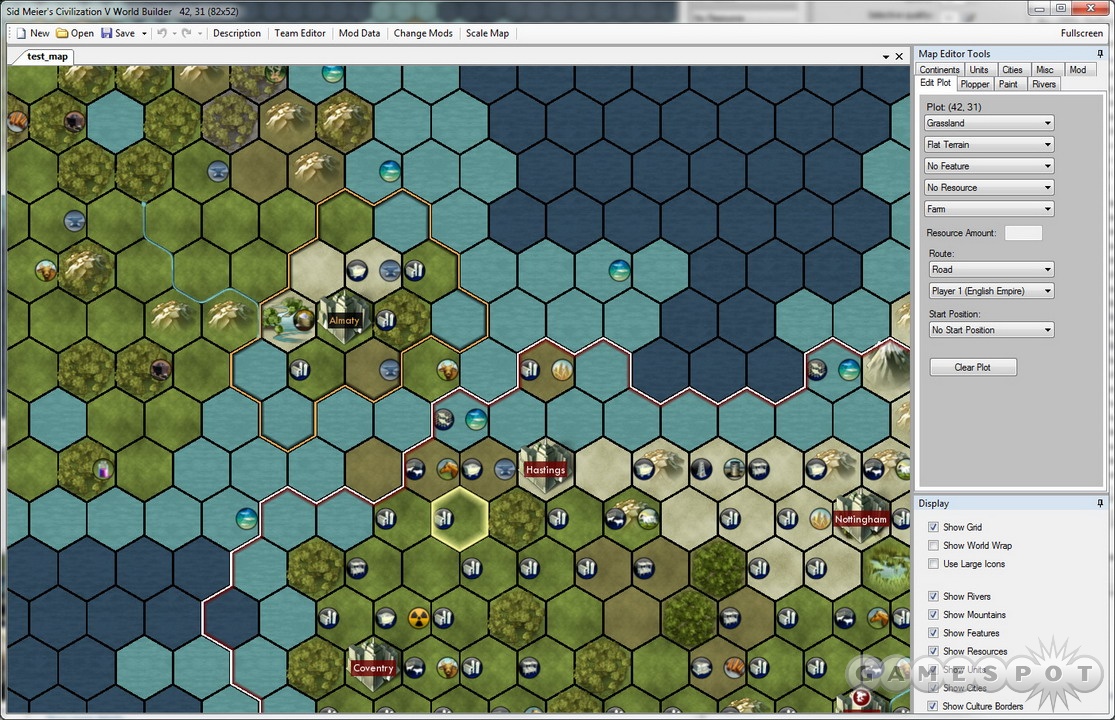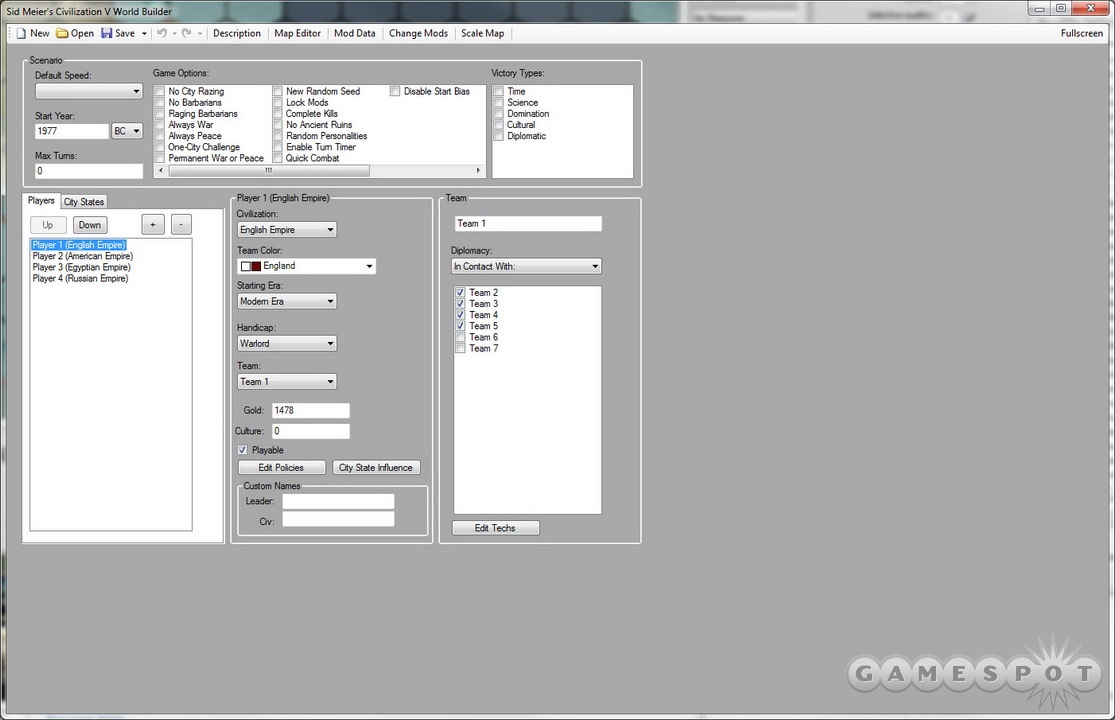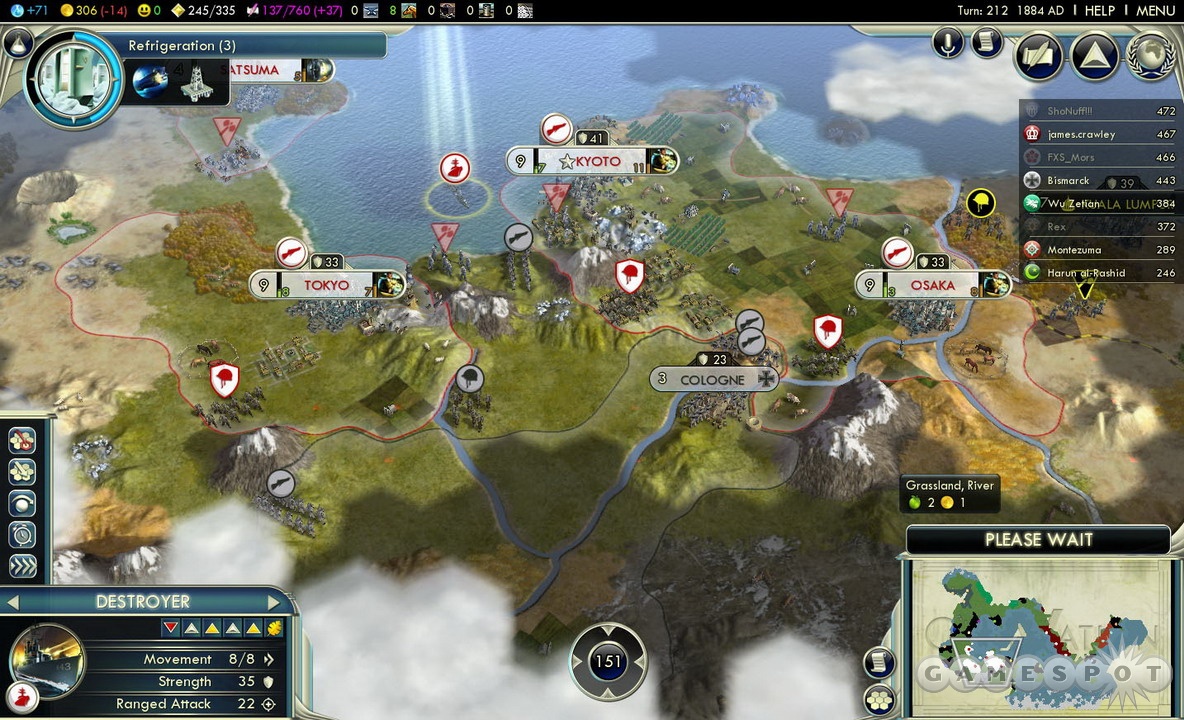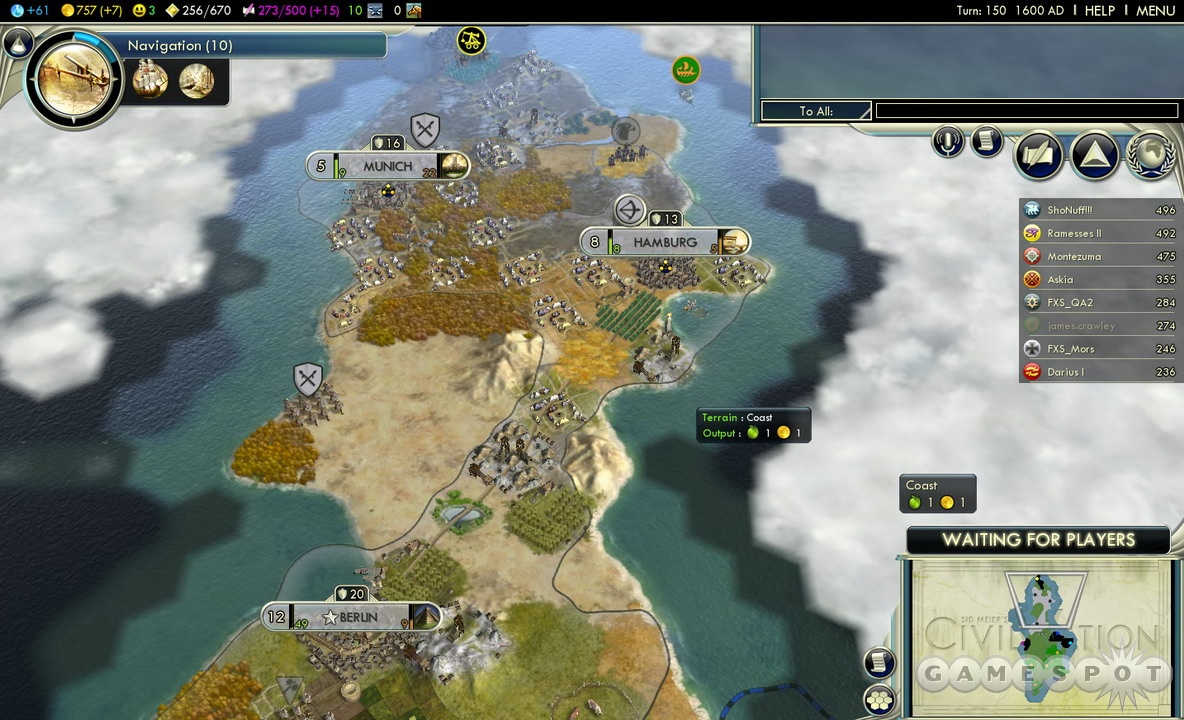Sid Meier's Civilization V Updated Hands-On - Exclusive Multiplayer and Editing Tools Report
We get a close-up look at Civilization V's extensive editing tools, and then jump into multiplayer with the creators of the game itself and get horribly slaughtered.
Civilization V is the fifth chapter in the beloved turn-based strategy series, and it's one of the most highly anticipated games of the year. And it's going to be here soon. We recently had a chance to visit the home of developer Firaxis to get an in-depth look at the game's editing and modification-making tools, and then we hunkered down for a multiplayer session with Firaxis staffers who have played the game much more than we have, which is why they beat us so badly. That's what we keep telling ourselves, anyway.
Another Crab's Treasure Is A Soulslike 3D Platformer | GameSpot Review Stellar Blade Review Nintendo 64 – April 2024 Game Updates – Nintendo Switch Online Super Monkey Ball Banana Rumble - Official Multiplayer Features Trailer PUBG | Erangel Classic Returns Gori: Cuddly Carnage | Meow Launch Date Announcement Trailer That Time I Got Reincarnated as a Slime ISEKAI Chronicles – Official Announcement Trailer MEGATON MUSASHI W: WIRED – Official OP “MUSASHI English Ver.” Trailer Stellar Blade - Official Launch Trailer | PS5 Games Gothic 1 Remake | Official Collector's Edition Trailer SaGa Emerald Beyond – Official Launch Trailer Paper Mario: The Thousand-Year Door – Official Switch Overview Trailer
Please enter your date of birth to view this video
By clicking 'enter', you agree to GameSpot's
Terms of Use and Privacy Policy
Our visit to the studio space began with a tour of Civ V's worldbuilder and other editing tools, which were built on the core of Civ IV's scripting and code base but have been streamlined and made much, much more user-friendly. The tools let you create maps of all sizes in the game, up to the "huge" size of 128 by 80 tiles (which we can tell you from experience is really quite huge).
The worldbuilder itself is remarkably easy to use, since it can generate a new map in a matter of minutes. While you can painstakingly build a giant map tile by tile, you can also use the random map generator to create one of the game's basic map types (Pangaea, archipelago, and so on) and use a paintbrush tool to change any and all of the terrain on the map (so you can add a nice schmear of forest through your pregenerated desert with a single stroke of the mouse). The worldbuilder also has numerous "ploppers" that let you drop down resources, starting cities, city-states, initial units, ruins, barbarians, and whichever other features you prefer, with a single click. You can even adjust the starting fog-of-war level to clear however much, or little, fog from the map's starting state you like, essentially to create a scenario where the "known world" extends only so far.
And you can easily tweak your own custom maps after saving what you're working on and then exiting the tools, firing up the game, and loading up the map to play it immediately. You can also use the game's "tuner" tool in-game, which lets you change in-game values and units in real time over the course of an actual game (making it a powerful cheating tool as well…but who'd ever cheat in a game of Civ, right?). Of course, if you prefer to go more in-depth, you can dig into the game's mod tools, which are, like Civ IV's, based on LUA and XML scripting languages contained in configuration files that can be freely edited.

Civ V's mods can take pretty much any form, from small-scale tweaks, like reskinning the user interface, to full-on total conversions, such as the test mod we saw in progress: "single large units," a tactical mod that starts all players with a preset handful of military units, which appear to be gigantic on the world map, and that plays less like a game of traditional Civ and more like a game of chess. As it turns out, you can set Civ V's mods to work directly with other mods (or to be exclusive of other mods), and as we've mentioned in our previous coverage, Civ V will let you search for mods using an in-game browser so that hopefully the work of diligent mod-makers can be found and played by more-casual users who might have otherwise been intimidated by having to search for them on the Internet, download them, and install them separately.
We then prepared ourselves to do battle in a four-man multiplayer match with several Firaxis staffers, including lead designer Jon Shafer, who, for the record, is a bloodthirsty monster and is not to be trusted in a Civ V multiplayer session. Civ V's multiplayer is powered by Steamworks, with all that software's accoutrements, such as Steam-based chat, friends lists, and support for voice chat that can be called up at any time. The actual in-game multiplayer interface is extremely clean and simple to use and resides entirely in the upper-right corner of the screen, where you can send chat messages to all players (or to a single player), keep track of each player's relative score, and even do a little wheeling and dealing to trade resources and other diplomatic goodies with each other. However, multiplayer is decidedly different from single-player, especially if you're up against aggressive opponents. While Civ V has many intriguing new strategic nuances, such as neutral city-states that can be joined as lucrative trading partners and a new cultural victory condition based on unlocking social policy trees, you're probably not going to want to spend all your time building peaceful wonders of the world if your buddies are breathing down your neck a dozen hexes away or so.

Our first match took place in the ancient era, and our indecision and lack of focus led to a horrible death. We played as China, a warlike nation with the powerful Chu-Ko-Nu crossbowman (which can fire twice, instead of once, like the standard crossbowman) and a national leader who produces great general units more frequently than other nations do. Great generals are one of the game's great people (along with great engineers, scientists, merchants, and artists), and they provide combat power bonuses to any allied units standing within two tiles, and China's great generals provide a larger combat bonus than the generals of other nations. But like all of Civ V's great people, these legendary units can also be expended within your national borders to immediately trigger a prosperous golden age, in which your nation produces more gold and more production resources.
We originally had a vague idea that we'd focus on cavalry units (which in Civ V, like in previous games, have more land movement points than infantry units) and hopefully get a great general or two on our side to rush our opponents' capitals. What we ended up with was a starting location with a whole bunch of spices and cotton and some nearby grain fields, and by the time we'd finished researching animal husbandry to cause horses to appear on the map, the beasts were sadly nowhere near our fledgling empire.
Another Crab's Treasure Is A Soulslike 3D Platformer | GameSpot Review Stellar Blade Review Nintendo 64 – April 2024 Game Updates – Nintendo Switch Online Super Monkey Ball Banana Rumble - Official Multiplayer Features Trailer PUBG | Erangel Classic Returns Gori: Cuddly Carnage | Meow Launch Date Announcement Trailer That Time I Got Reincarnated as a Slime ISEKAI Chronicles – Official Announcement Trailer MEGATON MUSASHI W: WIRED – Official OP “MUSASHI English Ver.” Trailer Stellar Blade - Official Launch Trailer | PS5 Games Gothic 1 Remake | Official Collector's Edition Trailer SaGa Emerald Beyond – Official Launch Trailer Paper Mario: The Thousand-Year Door – Official Switch Overview Trailer
Please enter your date of birth to view this video
By clicking 'enter', you agree to GameSpot's
Terms of Use and Privacy Policy
We switched our focus to researching economic advancements, such as the pottery technology (a tech that, as usual, lets you build food-storing granaries in your cities), which leads directly to the calendar technology (which lets you use worker units to build money-producing plantations on top of luxury resources, like spices and cotton). But just a few turns into the game, we bumped into another Firaxis staffer's holdings. We maintained a polite distance and since luxury resources like spices and cotton still contribute to the overall happiness of your nation's population, we even swapped some of our luxury resources with our neighbor for the sole purpose of mutually promoting our respective nations' happiness level. Yes. Yes...that should stick.
We'd already trained a scout unit to check the lay of the land, and through blind luck, we found a set of ruins (Civ V's version of the "goodie hut," which grants you a random bonus when you walk over it) that granted us a settler unit to build a second city, which we settled next to some deer and more grain. Since we had a cordial relationship with our nearest neighbor, we decided to invest in our population in the short term, focusing on building out our city with granaries, game trapping camps, and farms.
We took advantage of the early gold windfall of having so many nearby resources by building a worker unit to build as many civic improvements as possible. We then switched back to military development, this time creating a barracks in each city (these structures grant 15 bonus experience points to new land units, advancing them a level as soon as they've been commissioned in that town), with the intention of unlocking iron working as soon as possible to reveal the iron resource on the map and unlock the swordsman, one of the most powerful military units of the ancient era. In the meantime, we'd fended off a handful of barbarians successfully and had also earned enough culture to start unlocking some social policies. We invested our first fistfuls of culture points in the "honor" social policy tree (an early-game military policy that initially gives you combat bonuses against roving barbarians and then unlocks other advantages, like bonus military experience and a free great general). This policy is an easy choice for China, given the nation's more-powerful great generals.

We'd killed off all marauding barbarians nearby, had a great general in our retinue, and had even created our first swordsman when Mr. Shafer and his legions of Persian swordsmen showed up. He moved in on both us and our neighboring ally at the same time, ruthlessly deploying clusters of upgraded swordsmen to crush both our armies simultaneously, growing even more powerful with his initial conquests because his own battles caused Persia to produce a great general, which he immediately traded for a golden age. Persia's golden ages last 50 percent longer than other nations' and also grant military units +10 percent combat strength and an additional movement point, so our lone swordsman was no match for Shafer's battalion of golden-age-powered swordsmen, despite our great general's combat bonuses. Within a dozen or so bloody turns, it was all over, and since we'd played the game on a "tiny"-sized map, set to the speed of "quick" (which drastically reduces the number of turns it takes to produce units and structures and to research new techs), the entire match ended in about an hour. Of course, you can set multiplayer parameters to start at different time periods (such as the modern age, where all players can bring paratroopers and tanks into battle in just a few turns), so you can most likely shorten the duration of a multiplayer match to an even tighter time frame...though you still may not want to plan it around your lunch break. Just in case.
In our defense, we will again point out that Shafer is the lead designer of the game, and therefore he has memorized optimal building and research orders, regardless of any opening circumstances. After he slaughtered us, he allowed us a peek at his computer screen, which revealed that the designer had been building up a sizable nation of four cities of his own. Though none of his citizens were particularly happy with the choice of aggressively expanding, the sheer size of the designer's holdings made it more likely that he'd have iron nearby once he had researched the iron working technology (he had plenty of the stuff, in fact), and his ruthless warmongering meant that he had generated at least a great general or two, which would lead to lengthy golden ages that superseded the public unrest. Rest assured, this is not an easy thing to accomplish by any stretch of the imagination, but if you're Civ V's lead designer, you can apparently find a way. "My policy in multiplayer is simple," Shafer explained. "No mercy for anybody." Plus, we had a cold that day and our neighbor's cat had gotten sick a week ago, so we were still kind of sad about that, also. You can see we had a very plausible excuse for losing. Yes...very plausible.

Civilization V will arrive very soon in both a regular edition and in numerous different preorder editions, including a boxed collector's edition at retail stores and an online version on Steam. These two editions are largely similar; both will come with the game's soundtrack and an art book, except that the boxed collector's edition will have collectible figurines, while the Steam version will not have figurines but will instead have a scanned version of the art book, plus an exclusive new playable civ, Babylon. Maryland's official Civ V day is September 21. Many sleepless nights await.
Got a news tip or want to contact us directly? Email news@gamespot.com
Join the conversation